Confectionery goods, from chocolates to candies and pastries, rely on a delicate balance of ingredients to achieve the desired taste, texture, and longevity. The role of food additives in confectionery is crucial as they enhance flavors, improve texture, preserve freshness, and add visual appeal.
This article explores common types of food additives used in confectionery goods and provides examples for each, along with their recommended dosages.
1. Sweeteners
Sweeteners are key to adding sweetness to confectionery products, impacting flavor, texture, and overall product quality. They exist in both synthetic and natural forms.
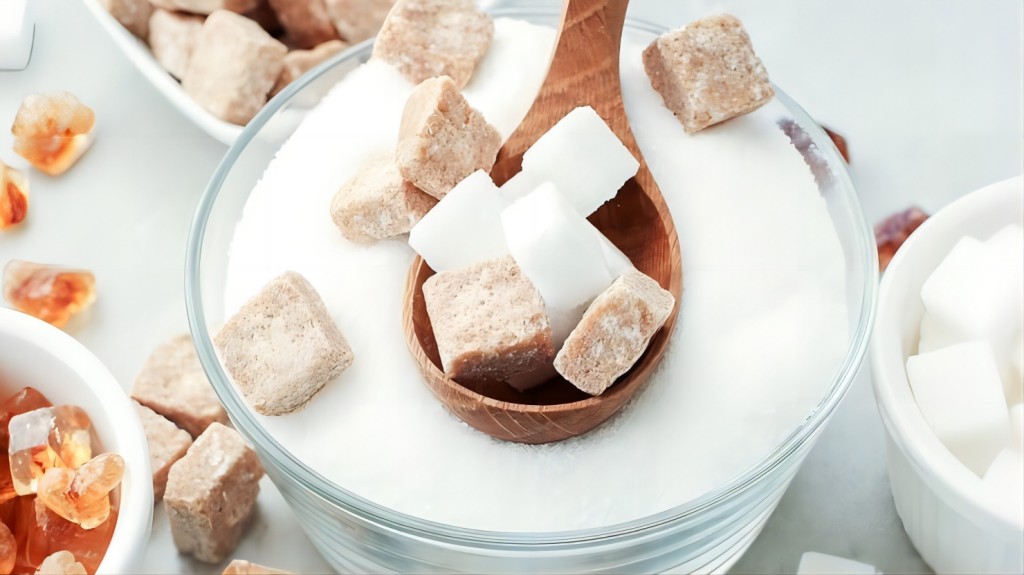
- Sucrose (Table Sugar): Widely used in confectionery to provide sweetness and crystalline structure. Based on the desired sweetness and type of confectionery, inclusions typically range from 50 to 70 percent of the overall product weight.
- Glucose Syrup: Derived from starch, adds sweetness while preventing crystallization, creating a smooth texture in candies. Generally used at 10-20% of the total formulation, depending on the confectionery type.
- High-Fructose Corn Syrup (HFCS): Known for its high sweetness level, used in soft candies and chewing gum to enhance sweetness and retain moisture. Typically used at 10-30% of the total product formulation.
- Sorbitol: A sugar alcohol used in sugar-free candies and gums as a low-calorie sweetener, reducing sugar content while maintaining sweetness and texture. Generally included at 5-10% of the total product formulation.
- Stevia: A natural, non-caloric sweetener derived from the Stevia plant, used in low-calorie confectionery products to provide sweetness. Typically included at 0.1-0.2% of the overall formulation.
2. Coloring Agents
Coloring agents enhance the visual appeal of confectionery products, providing vibrant colors that attract consumers. These additions may be synthetic or natural.
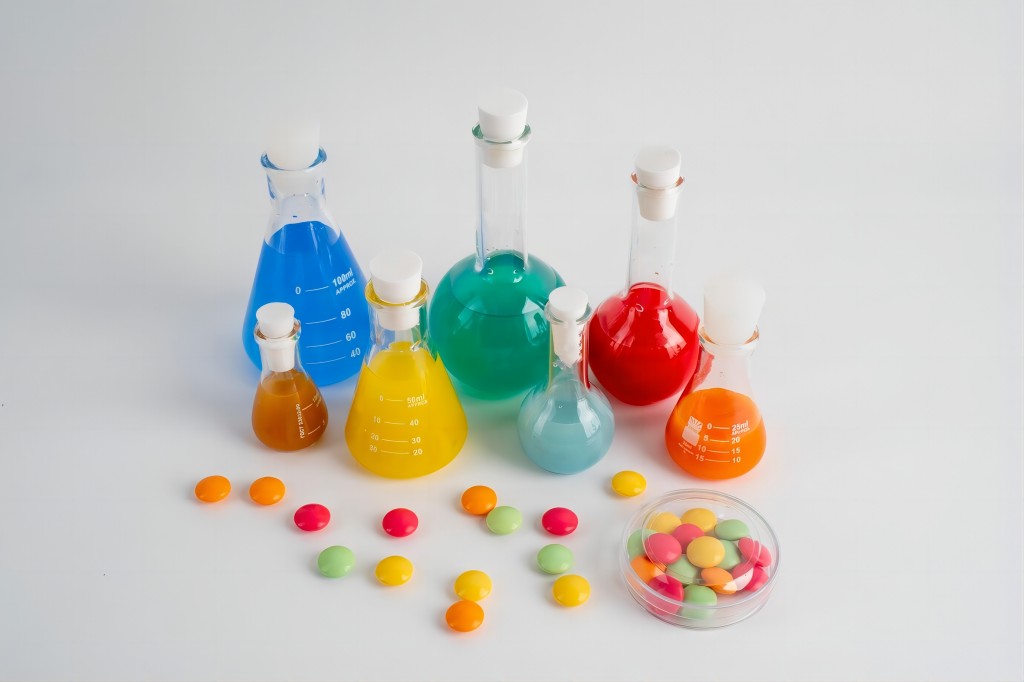
- Erythrosine (E127): A synthetic red dye used in gummies and jellies to provide a vibrant red color. The maximum acceptable daily intake (ADI) is 0.1 mg/kg of body weight.
- Beta-Carotene (E160a): A natural pigment that imparts an orange-yellow hue to products like orange-flavored candies. Typically used at concentrations between 0.01% and 0.05% of the product weight, depending on the desired color intensity.
- Tartrazine (E102): A synthetic yellow dye widely used in lemon-flavored candies and gummies. The acceptable daily intake (ADI) is 7.5 mg/kg of body weight.
- Anthocyanins (E163): Natural pigments derived from fruits and vegetables like grapes and berries, providing purple to blue hues in confectionery. Typically used at concentrations of 0.1-0.2% of the product weight, depending on the desired color.
- Carmine (E120): A natural red dye obtained from cochineal insects, often used in high-end candies and chocolates to produce a rich, deep red color. Typically used at concentrations between 0.01% and 0.5%, depending on the required color intensity.
3. Flavor Enhancers
Flavor enhancers improve and intensify flavors in confectionery products, ensuring consistency and a balanced taste across batches.
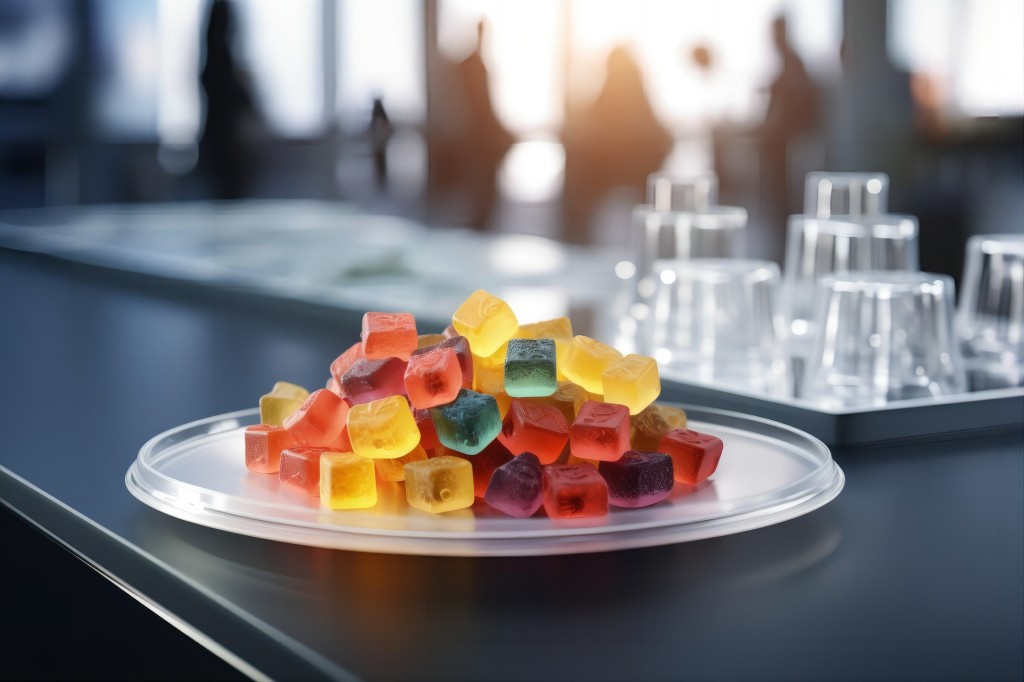
- Vanillin: Used in chocolates, caramels, and toffees to provide a sweet, creamy flavor. Typically used at concentrations of 0.05-0.1% of the product weight, depending on the desired flavor intensity.
- Ethyl Maltol: A synthetic flavor enhancer that adds a sweet, caramelized taste to baked goods and candy coatings. Typically used at concentrations between 0.001% and 0.05% of the product formulation, depending on the desired flavor profile.
- Monosodium Glutamate (MSG): Commonly used to enhance umami flavor in savory confectionery items like snacks and flavored nuts. Usually applied at weight concentrations of the substance between 0.1% and 0.8%.
- Maltol: Adds a sweet, toasty flavor to confections, similar to caramel or freshly baked bread. Typically used at concentrations ranging from 0.01% to 0.1% of the total formulation, depending on the desired taste.
- Citric Acid (E330): Commonly used in sour candies and gummy products to enhance tartness and balance sweetness. Typically used at concentrations ranging from 0.05% to 0.3% of the product weight, depending on the level of tartness desired.
4. Emulsifiers
Emulsifiers ensure that ingredients in confectionery products are evenly mixed, which is crucial for maintaining texture and consistency, especially in products containing both fats and water-based ingredients.

- Lecithin (E322): Derived from soy or sunflower, it is used in chocolates and caramels to improve texture and prevent separation. Typically included at concentrations of 0.3-0.5% of the product weight, depending on the specific formulation.
- Mono- and Diglycerides (E471): Commonly used in baked goods, confections, and icings to maintain consistency and prolong shelf life. Typically used at concentrations of 0.2-1.0% of the total product weight.
- Polysorbate 60 (E435): A synthetic emulsifier that stabilizes mixtures and creates a uniform texture in whipped toppings and confections. Generally used at concentrations of 0.1-0.2% of the product weight.
- Sorbitan Monostearate (E491): Used as an emulsifier in candies, icings, and frostings to stabilize emulsions and prevent crystallization.usually applied in concentrations between 0.2% and 1.0% of the weight of the finished product.
- Sucrose Esters (E473): Improve mouthfeel and texture in various confectionery products by creating a stable emulsion. Typically used at concentrations of 0.3-0.5% of the total product weight.
5. Preservatives
By halting microbiological development and spoiling, preservatives increase the shelf life of confectionery goods while maintaining their freshness and safety for ingestion.
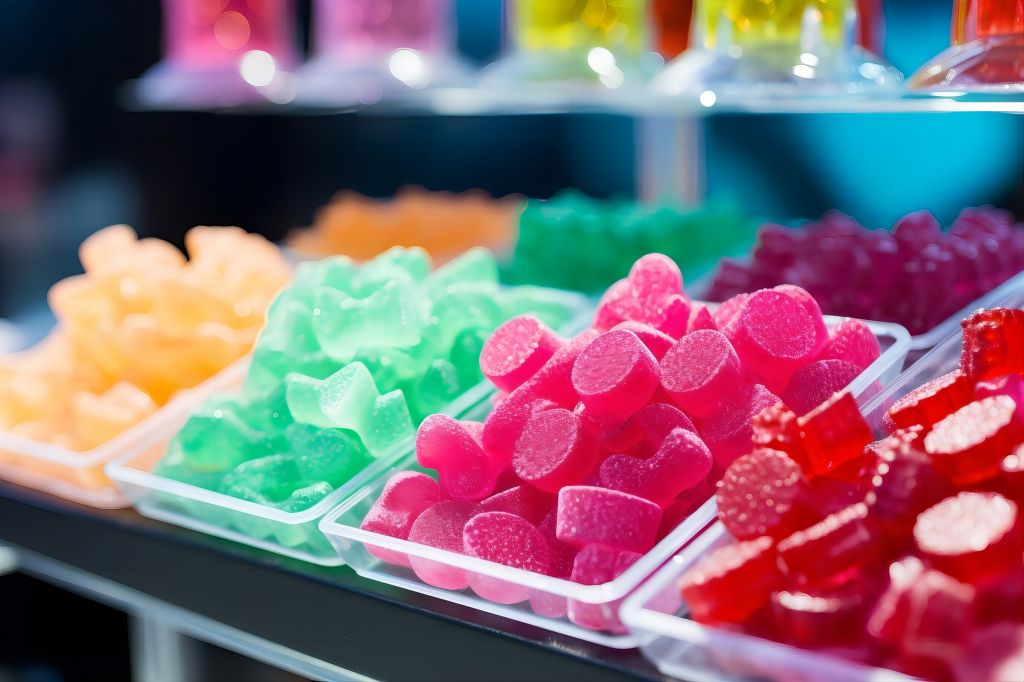
- Sodium Benzoate (E211): A widely used preservative in jellies, gums, and candies to prevent mold and yeast growth. The maximum permissible limit is 0.1% of the total product weight.
- Potassium Sorbate (E202): Commonly used to prevent mold and yeast growth in candies, icings, and chocolate products. Often applied at weight percentages of the product varying between 0.025% and 0.1%.
- Calcium Propionate (E282): A preservative used in baked confectionery items to prevent the growth of mold and bacteria. Usually utilized in weight percentages of the final product ranging from 0.1% to 0.3%.
- Sulfur Dioxide (E220): Used as a preservative in dried fruit and candies to prevent oxidation and microbial growth. The maximum allowable limit ranges from 0.01% to 0.1% of the product weight, depending on the specific formulation.
- Sodium Nitrite (E250): Used in certain cured confectionery meats, such as jerky, to preserve color and prevent bacterial growth. The maximum allowable limit is 200 ppm (parts per million) of the total product formulation.
6. Thickeners and Stabilizers
Thickeners and stabilizers play a critical role in achieving the desired consistency, texture, and stability in confectionery products, ensuring that products maintain their shape and mouthfeel over time.
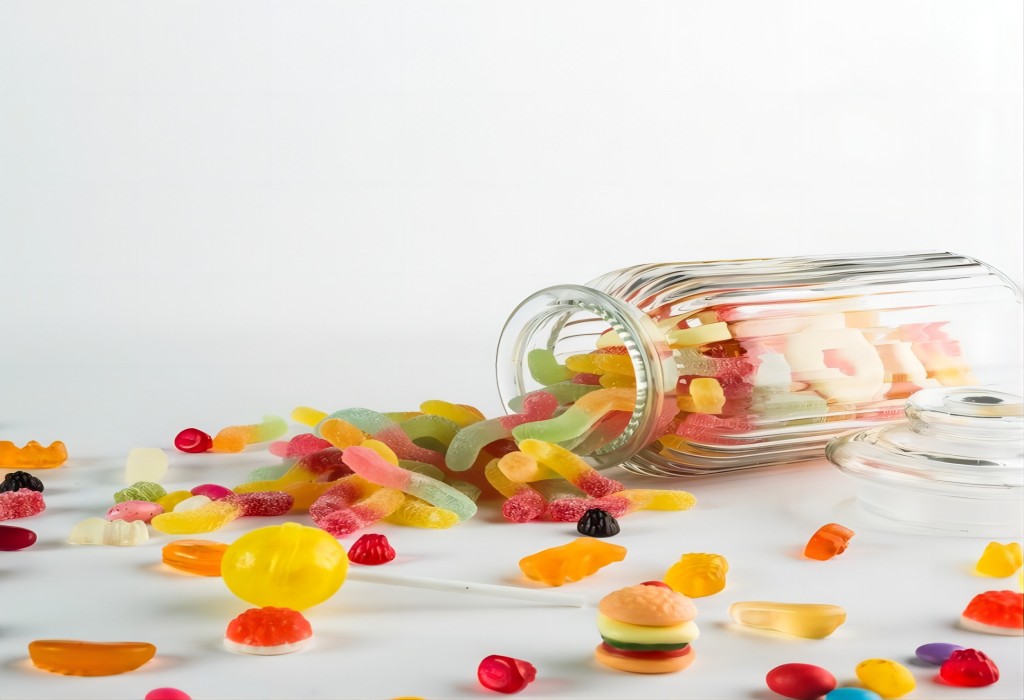
- Pectin (E440): A natural thickener derived from fruits, commonly used in gummies, jellies, and fruit-flavored candies to create a gel-like consistency. Typically used at concentrations of 0.5-1.5% of the product weight, depending on the desired firmness and texture.
- Gelatin: Derived from animal collagen, widely used as a thickener and stabilizer in marshmallows, gummies, and chewy candies. Helps create a firm yet flexible texture, generally included at concentrations of 1-5% of the total product weight, depending on the required consistency.
- Agar-Agar (E406): A plant-based gelling ingredient made from seaweed that is frequently used for gelatin in confectionery by vegetarians. Provides a firm texture, typically used at concentrations ranging from 0.5% to 2.0% of the product weight, depending on the specific formulation.
- Carrageenan (E407): A natural thickener extracted from red seaweed, commonly used in jellies, puddings, and dairy-based confectionery products. Stabilizes texture and prevents separation, typically used at concentrations of 0.1-1.5% of the total product weight.
- Xanthan Gum (E415): A versatile thickening agent used in various confectionery products, including candies, sauces, and icings. Stabilizes emulsions and suspensions, typically used at concentrations of 0.05-0.3% of the product weight, depending on the desired texture and viscosity.
7. Acidulants
Acidulants are used to adjust the acidity of confectionery products, enhancing flavor, providing tartness, and improving product stability. They are especially important in fruit-flavored candies and sour treats.
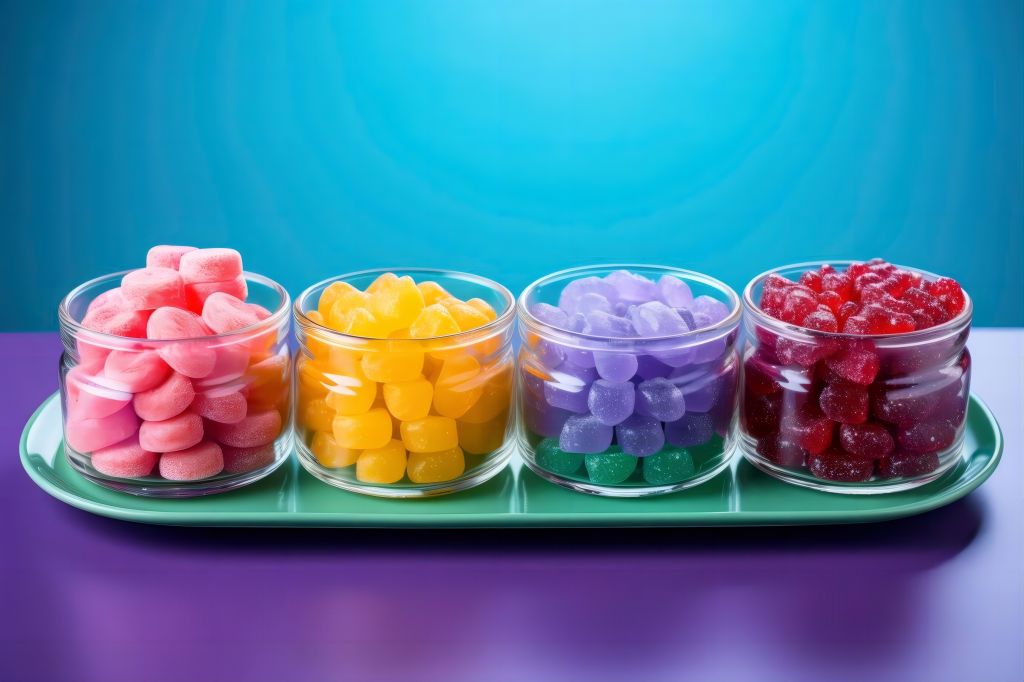
- Citric Acid (E330): One of the most commonly used acidulants in confectionery, providing a sharp, tart flavor in sour candies, gummies, and beverages. Enhances flavor and balances sweetness, typically used at concentrations ranging from 0.05% to 0.3% of the total product weight, depending on the desired tartness.
- Malic Acid (E296): A popular acidulant often used in fruit-flavored candies for its intense, long-lasting sour taste. Enhances the flavor of fruit and berry-based products, typically used at concentrations ranging from 0.1% to 0.5% of the product weight, depending on the desired sourness.
- Lactic Acid (E270): Commonly used in dairy-flavored candies and caramels to provide a mild, tangy acidity. Also helps preserve the product by lowering pH, typically used at concentrations of 0.1-0.3% of the total product weight.
- Tartaric Acid (E334): Frequently used in hard candies and gummies to provide a strong, sharp sour taste. Enhances flavor stability and is often used in combination with other acidulants, typically at concentrations of 0.05-0.2% of the product weight.
- Fumaric Acid (E297): A potent acidulant known for its long-lasting sour taste, commonly used in dry-mix beverages, sour candies, and gummy products. Provides robust tartness and is typically used at concentrations of 0.1-0.3% of the product weight.
8. Humectants
Additives known as humectants aid in the retention of moisture in confectionary goods, keeping them from drying out and guaranteeing that they stay chewy, soft, and fresh throughout time.
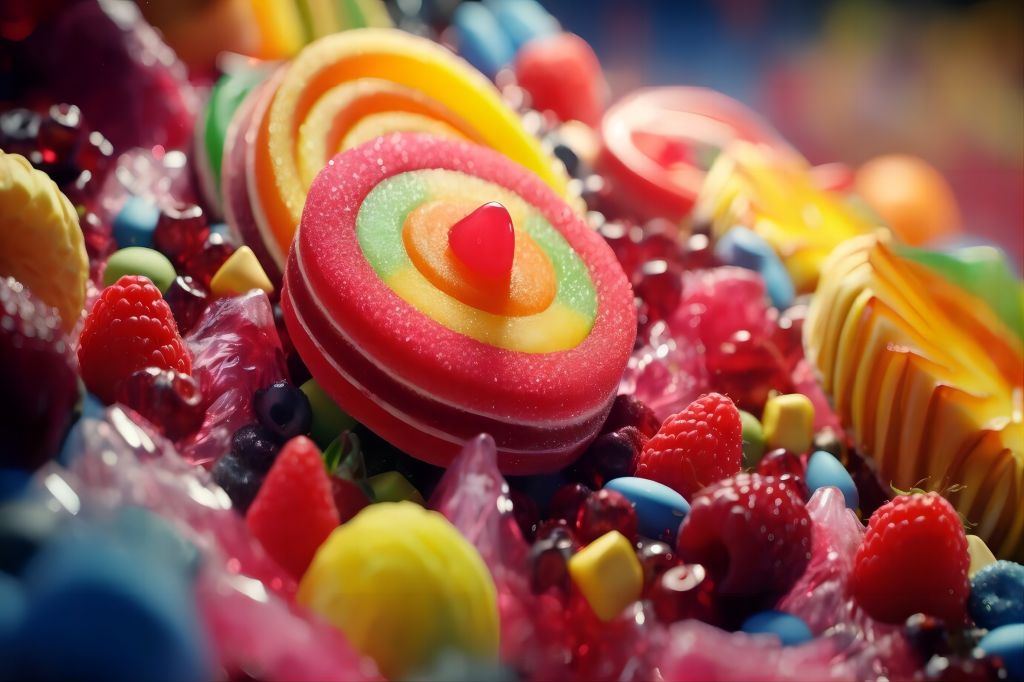
- Glycerol (E422): Widely used as a humectant in soft candies, chewing gum, and frostings. keeps the product from getting overly dry or brittle by aiding in moisture retention. Usually used in amounts between 2 and 5% of the product’s total weight, depending on the required moisture content.
- Sorbitol (E420): A sugar alcohol serving as both a sweetener and humectant in sugar-free candies, gums, and other confections. Helps maintain moisture and freshness, typically used at concentrations of 5-15% of the product weight.
- Propylene Glycol (E1520): Used in chewy candies, icings, and other confectionery products to help maintain moisture and softness over time. Also stabilizes flavors and colors, typically used at concentrations of 1-5% of the total product weight.
- Honey: A natural sweetener and humectant that is utilized in a variety of candies, baked products, and chocolates. Adds moisture while contributing to sweetness and flavor profile. Typically used at concentrations of 5-15% of the total product weight, depending on the formulation.
- Glucose Syrup: Acts as both a sweetener and humectant in products like caramels, toffees, and nougats. Helps retain moisture, prevents crystallization, and ensures a smooth texture. Typically used at concentrations of 10-30% of the product weight, depending on the specific confectionery item.
9. Antioxidants
Antioxidants are used in confectionery products to prevent oxidation, which can lead to rancidity, flavor degradation, and color changes. Their ability to preserve fats, oils, and other delicate constituents helps products have longer shelf lives.

- Ascorbic Acid (E300): Also known as Vitamin C, a natural antioxidant that helps prevent oxidation and maintain color in fruit-flavored candies, gummies, and other confections. Typically used at concentrations of 0.01-0.2% of the total product weight, depending on the formulation and specific needs of the product.
- Tocopherols (E306): Also known as Vitamin E, natural antioxidants are used in chocolates, coatings, and other fatty confections to prevent rancidity. They protect against the degradation of fats and oils, typically used at concentrations of 0.01-0.2% of the product weight.
- Butylated Hydroxyanisole (BHA) (E320): Commonly used in oily or fatty confections, such as chocolate coatings and snack bars, to prevent oxidation and extend shelf life. Generally used at concentrations of 0.02-0.05% of the product weight, depending on the formulation.
- Butylated Hydroxytoluene (BHT) (E321): A synthetic antioxidant used to protect fats in confectionery products from oxidation. Commonly used in conjunction with BHA and typically included at concentrations of 0.02-0.05% of the total product weight.
- Propyl Gallate (E310): A synthetic antioxidant often used alongside BHA and BHT to prevent oxidation in fatty confections. Helps protect the product from rancidity and is typically used at concentrations of 0.01-0.1% of the product weight.
Conclusion
Food additives improve flavor, color, texture, and shelf life, which is important for the confectionery sector. Whether natural or synthetic, these additives ensure that confectionery goods maintain their quality, appeal, and freshness from production to consumption.
Understanding the types of food additives and their appropriate usage levels is essential for producing safe and desirable confectionery products. As consumer preferences evolve, the strategic use of these additives will remain a key factor in meeting market demands and creating innovative confectionery items.
